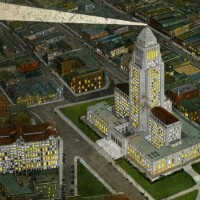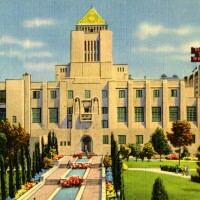Los Angeles in Buildings: The Braly Block

I once took a Los Angeles Conservancy architecture tour whose leader, having brought us atop Bunker Hill, gestured toward an old building over on Spring Street and told us a story from his former career as a city employee. One day he needed a ride home and a higher-up in his department offered it. Generous though that act might make him seem, this man's job, as our tour guide described it, required the opposite of large-heartedness: he spent most days at the office finding reasons to reject as many of the building or rebuilding proposals that crossed his desk as possible, and spent the entire hour's drive to Long Beach laying acerbically into the developer responsible for the latest pile of paperwork in his inbox: some guy who wants to do a residential conversion of some empty offices downtown, a dreamer so delusional that “he actually believes people are going to live on Spring Street!”

That developer, as anyone with an eye on the transformation of modern Los Angeles will have guessed, was Tom Gilmore, the gregarious New Yorker now widely credited with sparking the return of a large residential population, and the varied day-and-night activity such a population brings, to a largely forgotten downtown. That anecdote gets a reliable laugh in the midst of a boom that makes its starring city official look like a blinkered record label executive sending away the Beatles or investor passing on Facebook. But by the late 1990s when Gilmore launched into his mission in earnest, longtime Angelenos had grown accustomed to hearing rumors of a coming downtown revival at least once a decade, rumors that never seemed to produce much enticement to go there, let alone move there. Yet at some point in the 2000s, it became undeniable that this one had actually taken.

No single architect had as much responsibility for the look and feel of Los Angeles' built environment at that time than John Parkinson, designer of the Braly Block.
The Spring Street structure the Conservancy guide pointed out was the Continental Building, first known when it opened in 1904 as the Braly Block. “That's L.A.'s first skyscraper,” says Tom Hansen, the young aspiring architect protagonist of Marc Webb's “(500) Days of Summer,” gesturing toward the building from his own Bunker Hill perch beside his titular romantic interest. That movie, one of the first set amid the renewed (if occasionally exaggerated) street life of 21st-century downtown Los Angeles, prominently features the architecture of the central city, or at least its architecture of the late 19th and early 20th century. Though he goes unnamed in the dialogue, no single architect had as much responsibility for the look and feel of Los Angeles' built environment at that time than John Parkinson, designer of the Braly Block.
An English immigrant who set up his Los Angeles practice in 1894, Parkinson no doubt looked like something of a delusional dreamer himself when first he arrived in town, but by the time of his death nearly forty years later, he'd crafted many if not most of his adopted hometown's signature buildings. His résumé includes City Hall, the Memorial Coliseum, the Homer Laughlin Building (known now as the home of Grand Central Market), the Bullocks Wilshire department store, and Union Station (not to mention the USC campus master plan and one fondly remembered renovation of Pershing Square park). California historian Kevin Starr describes him as not just an architect but “a sort of a founder of Los Angeles, especially in the 1920s.”
Stephen Gee, author of “Iconic Vision: John Parkinson, Architect of Los Angeles,” considers Parkinson “the dominant architect over that time period when L.A. transforms from basically an outpost to a booming metropolis.” When I interviewed him in his office high above downtown in the U.S. Bank Tower (the skyscraper that will hold the title of Los Angeles' tallest building, as the Braly Block once did, until next year), Gee lamented the excessive “attention in Los Angeles on architects such as Neutra and Schindler that really made their reputations designing expensive private houses” when Parkinson “designed the public structures that still define Los Angeles.” And he did it with taste: “They're neat, they're elegant, they're well-organized, they're classy. There's a real absence of any kind of gaudy decoration.”

Like the Pico House and the Bradbury Building, the Braly Block first rose at the behest of a wealthy man. John Hyde Brady, president of the Southern California Savings Bank, wanted to put a classical building on Fourth and Spring, Spring fast becoming “the Wall Street of the West,” and in 1902 went to Parkinson, best known at the time for his then-high-tech Homer Laughlin Building, Los Angeles' first Class "A" fireproof steel-frame structure, for its design. The realized building made use not just of another still-cutting-edge steel frame, but fire-resistant interior masonry walls, built-in wiring, and a coat closet for every office. Its 12 stories came to 175 feet in total (some sources report 13 stories and 151 feet), towering for a time over everything else in the city and, at least by the standards of the day, boasting a positively flamboyant upper façade.
City Hall dwarfed it, and every other building in its league, in 1928. But Parkinson himself had a hand in designing it, as well as a hand in wrangling an exception from the 150-foot height restriction passed after the Braly Block's completion. Stylistically speaking, time has treated these and Parkinson's other surviving projects kindly indeed. “When I look at downtown, I think that the Parkinson structures still work,” said Gee as we spotted a few through his office windows. “I think the ones that surround them don't.” One sees the quality of Parkinson's buildings looking up from the street as looking down from above. “There’s so much beauty here,” says Tom Hansen as he gives Summer his Beaux-Arts tour of the Historic Core. “Sure, the street level isn’t much to look at, but if you look up, there’s some exciting stuff going on. If it were up to me, I’d get people to notice!”

Before the downtown revival caught on, Tom Gilmore no doubt said many a variation on the same line himself. “In Los Angeles we're ashamed of our downtown,” he told Los Angeles Times columnist (and future business partner) Robert A. Jones in 1999. “We have dozens of beautiful old buildings, the kind that people die for in New York, and we treat them like eyesores, as if we're waiting for them to fall down so we can sweep the bricks away and build another parking garage. Those buildings can be filled with people. There's a segment of the population that's hungry for city life. I look at those empty streets and I see little cafes along the sidewalk and a canopy of trees. I see lights in the windows of the buildings because someone lives up there. And that picture won't leave my mind. It just makes sense.”
As much an urbanist messiah as a developer, Gilmore understood that no building works unless the neighborhood around it works, unlike colleagues who put all their energies into self-contained structures (as John Portman did with the Bonaventure Hotel, to name just one of the examples up on Bunker Hill). To that end he and his partners, taking first advantage of the city's 1999 Adaptive Reuse Ordinance that made it cheaper to renovate and repurpose the old than to tear them down and build anew, acquired several early 20th-century commercial buildings, all located between Spring and Main, practically unaltered since the Second World War, and mostly deserted: the Farmers and Merchants National Bank Building, the San Fernando, the Hellman, and, renamed the Continental in the years since its construction, the Braly Block.

Bannered the “Old Bank District,” the project came down to what Jones described as a $32 million bet “that Gilmore and his development firm, Gilmore Associates, can re-civilize the ruins of downtown's historic district and restore urban life to the city's core,” distinguished by the fact that while “other developers have rehabilitated individual buildings downtown and the master planners of local government have built one futile monument after another to the gods of urban renewal [ … ] no one has marched into the great dead zone, now populated by the deranged and besotted, and vowed to build a working neighborhood.” The Old Bank District filled up with residents almost immediately; people, it seemed, wanted to live on Spring Street after all.
As much as the ever more functional neighborhood has changed, Parkinson would easily recognize his work still today, thanks in large part to downtown’s decades of neglect, which meant that many of its buildings, according to Gee, “weren't renovated in a way that destroyed their character. If it had been in New York or Chicago where that real estate had been consistently valuable, you would have lost a lot of the character that still exists in these buildings.” Those who stroll just outside the doors of the Braly Block can glimpse the character of at least 12 Parkinson buildings, including the Security National Bank Building (which became the Los Angeles Theatre Center in a previous, early-1980s downtown revitalization bid), the Title Insurance Building (currently under renovation into “creative offices”), and the Alexandria Hotel (now a mix of low-income single-room occupancy housing and high-end lofts).
Just a block up Spring, John Parkinson Square, dedicated in 2014, celebrates the ambitious architect's long-ignored legacy. A public square filled with Angelenos engaging in the bustle of downtown street life would make the perfect tribute to the man who, like Tom Gilmore or indeed Tom Hansen after him, grasped the urban potential of Los Angeles as few around him could — but unfortunately, in the manner of so many Los Angeles “squares,” Parkinson's amounts to nothing more than a branded traffic intersection still traversed day and night by cars, albeit one framed by nicer buildings. Apparently some of Los Angeles' habits die harder than others.



